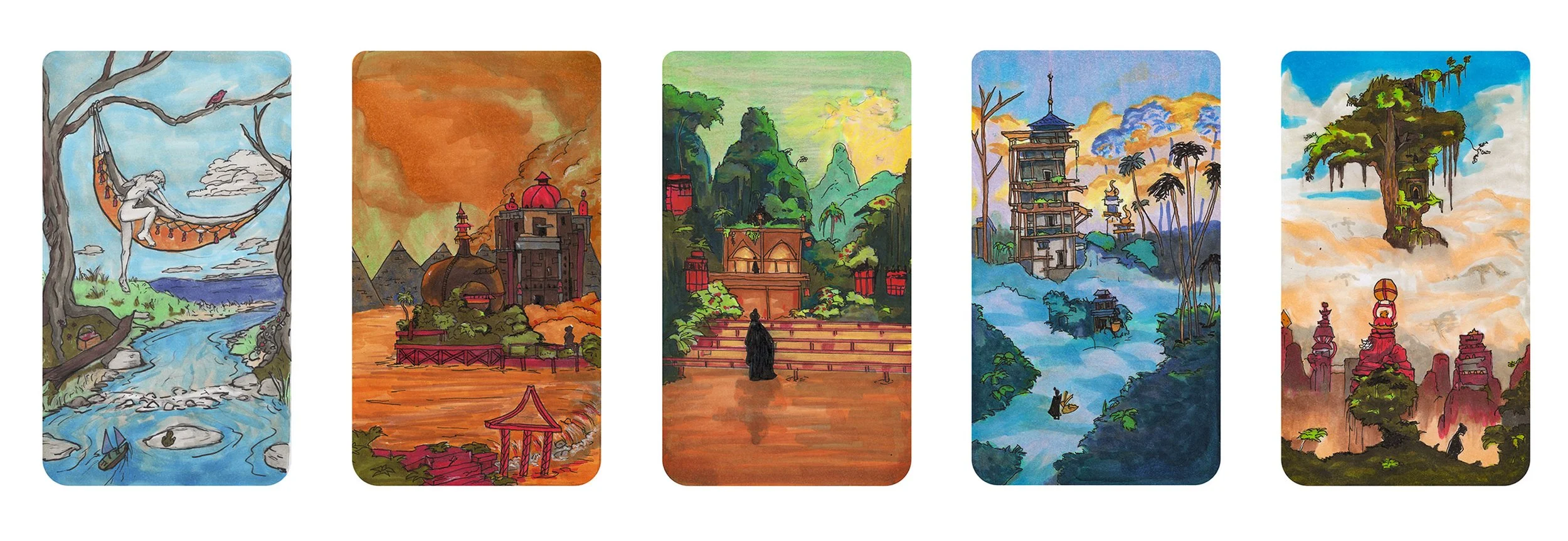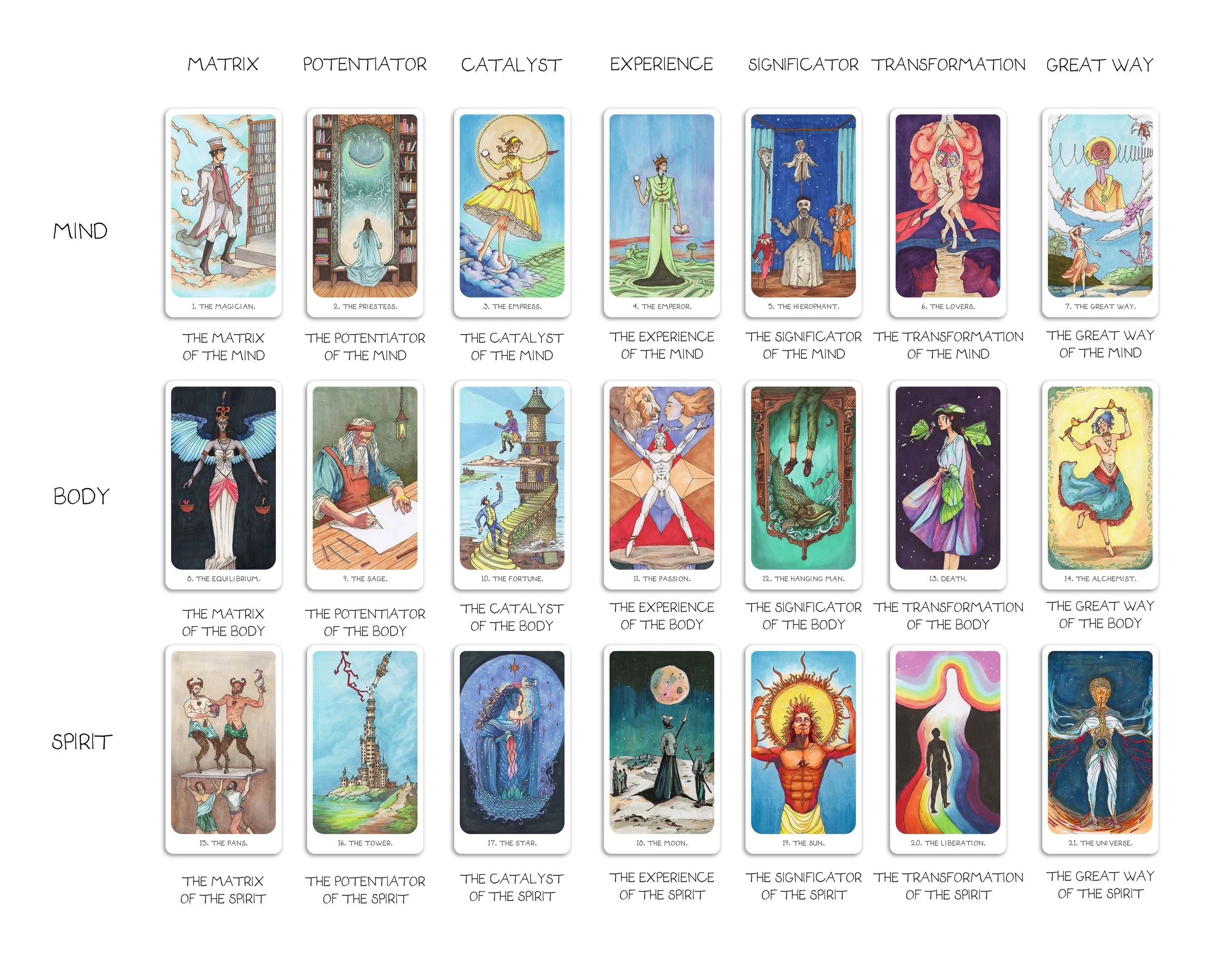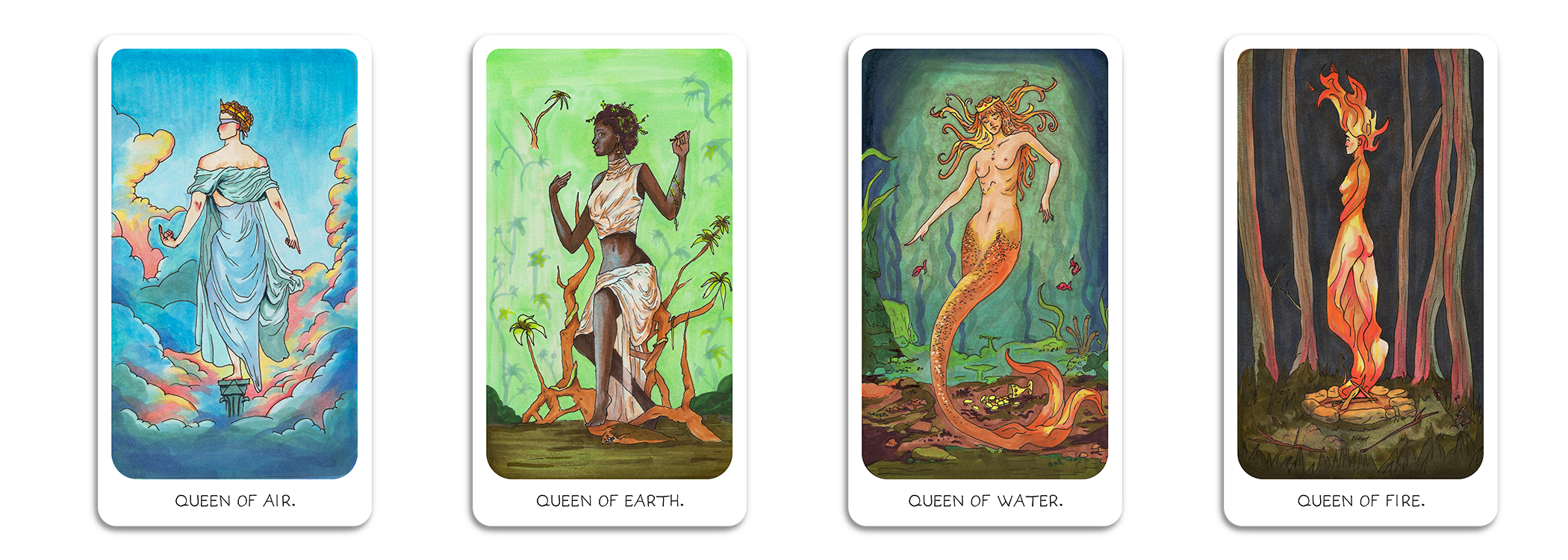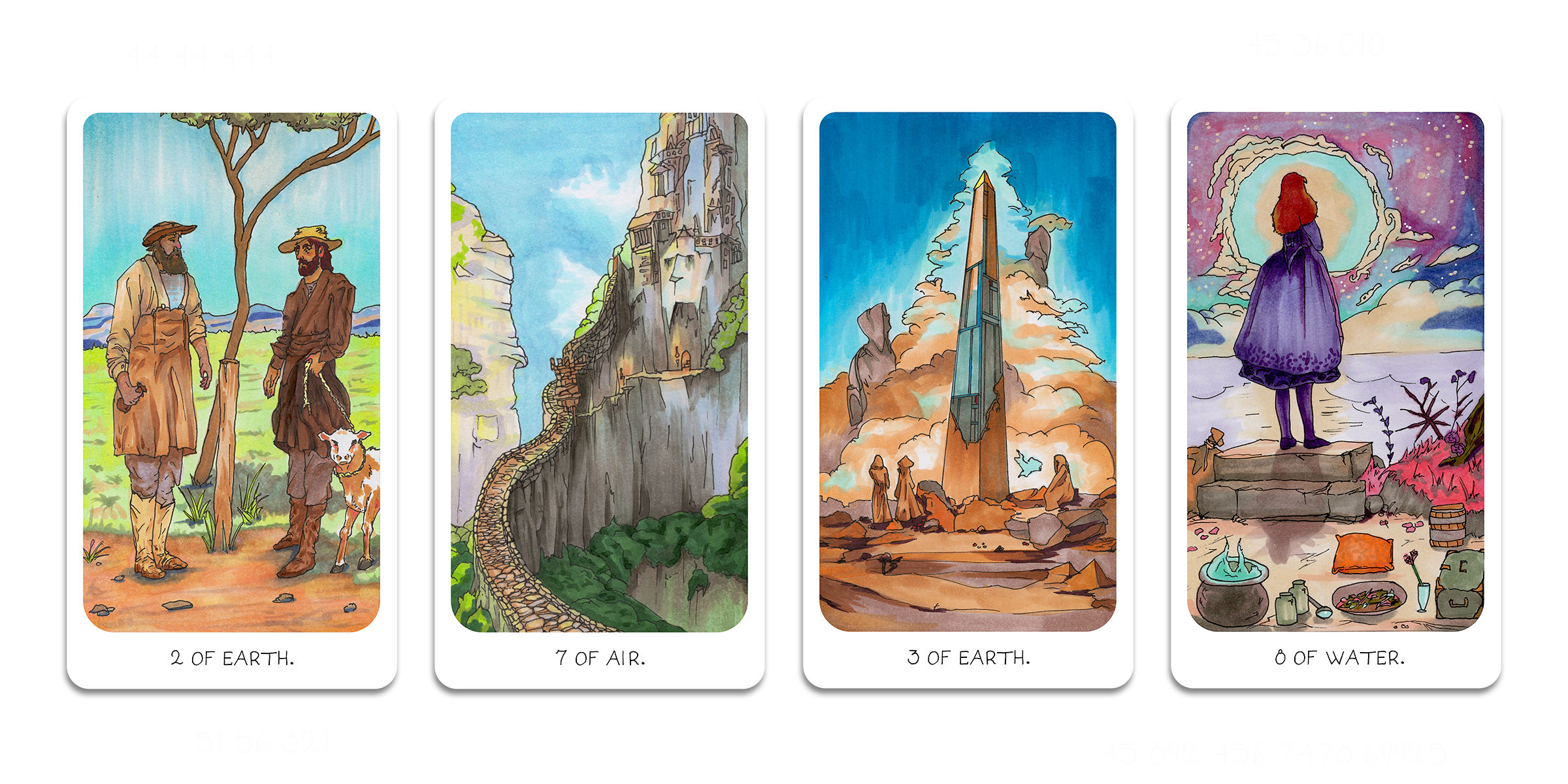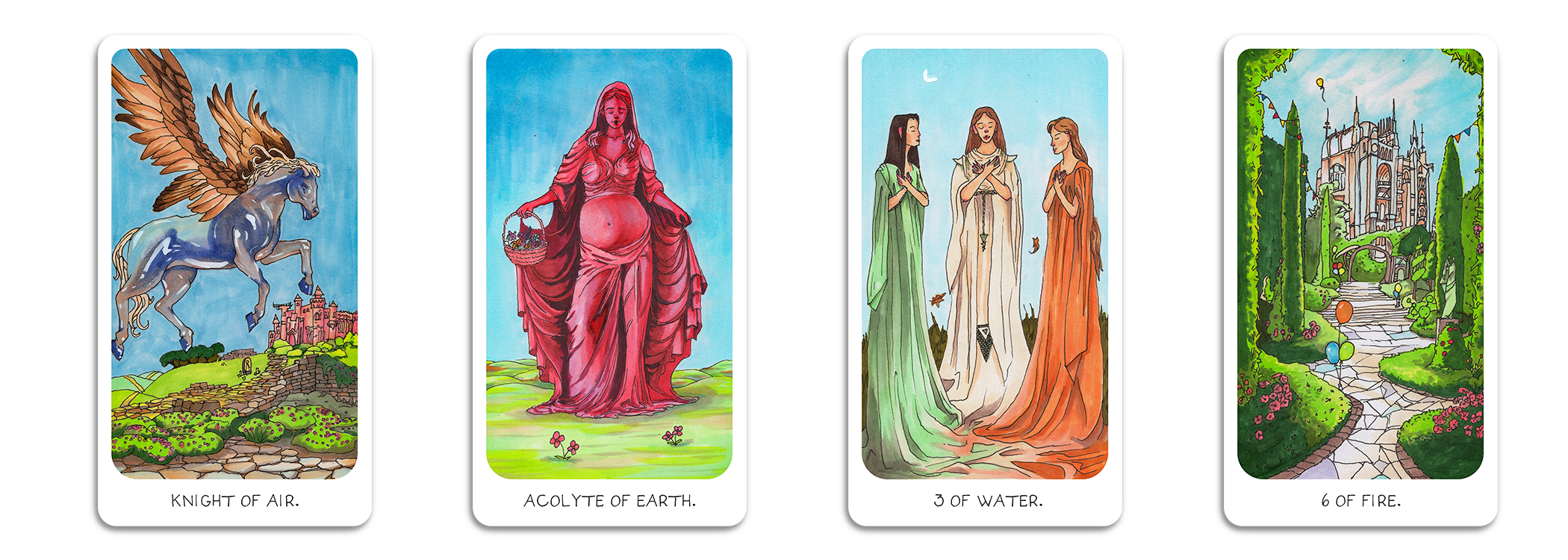Interpreting The Journey Tarot Deck
Before we delve into the heart of this guide, I want to underscore the intrinsic subjectivity of interpreting the Journey Tarot deck, a quality it shares with the range of human emotions. The very essence of this deck is the kaleidoscope of unique interpretations it can inspire, depending upon the reader's personal journey, intuition, and situation. In this guide, I aim to equip you with a foundational understanding and effective tools to navigate your personal interpretations.
First we’ll go through the tarot basics, then we will explore the visual elements that may help you form your interpretations of the cards in the Journey Tarot Deck.
The Basics
At the core of the Journey Tarot deck are two essential parts: the Major Arcana and the Minor Arcana. Each part serves a distinct purpose and offers a different lens through which we can view and interpret our experiences.
The Major Arcana
The Major Arcana, often referred to as "The Fool's Journey," is a symbolic narrative depicting the different stages of a soul's journey towards self-realization. It comprises 22 cards, each symbolizing a significant stage or archetype we encounter on our personal and spiritual journeys. From the Fool (representing innocence, beginnings, and potential) to the Universe (symbolizing completion and unity), these cards echo universal themes and lessons that resonate deeply within the human experience.
Mind - Body - Spirit Complex
Another layer of interpreting the Major Arcana is through the lens of three different complexes - the Mind, the Body, and the Spirit. This perspective ties the journey of tarot into a holistic view of human existence, acknowledging our multifaceted nature.
Each complex corresponds to seven stages: the Matrix, the Potentiator, the Catalyst, the Experience, the Significator, the Transformation, and the Great Way. The Major Arcana cards numbered from 1 to 7 correspond to the Mind complex, cards 8 to 14 are aligned with the Body complex, and cards 15 to 21 map onto the Spirit complex.
For example, Card 1 - The Magician, in this interpretation, is seen as the Matrix of the Mind. This suggests that The Magician represents the origin, the starting point, or the backdrop upon which the mind complex plays out. The Magician is known as a symbol of will, skill, and the harnessing of personal power, and in this context, it sets the stage for mental capacities and our cognitive journey.
You can find more information with this Article: The Mind • Body • Spirit Complex
Mind - Body - Spirit Complex Chart
The Minor Arcana
The Minor Arcana, in contrast, deals more with the tangible, day-to-day aspects of life. It represents the interactions and activities of the archetypal forces in the material world, reflecting our experiences, emotions, thoughts, and actions. The Minor Arcana is broken down into four elemental suits: Fire, Water, Air, and Earth. Each suit corresponds to different aspects of life—Fire with action and passion, Water with emotions and intuition, Air with thoughts and communication, and Earth with material aspects and practicalities. Numerology plays a crucial role in understanding these cards, particularly the numbered cards ranging from two through ten.
Fire ↔ Wands ● Water ↔ Cups ● Air ↔ Swords ● Earth ↔ Pentacles/Disks Aces
The Aces in the Tarot deck hold a special place as they symbolize the essence and potential of their respective suits. They are cards of beginnings, representing the pure, unaltered state of the elemental forces they represent – Fire, Water, Earth, and Air. Each Ace stands for the possibilities, opportunities, and the inherent potential of these elemental energies.
Ace of Fire - The Ace of Fire represents the essence of the Fire element, embodying the spark of creation, inspiration, and action. It represents a primal force of transformation that drives ambition and initiates new ventures. When the Ace of Fire appears, it suggests the seed of a powerful enthusiasm, a new venture, or an exciting start.
Ace of Earth - Representing the quintessence of the Earth element, the Ace of Earth symbolizes the seeds of prosperity, physical health, and material gain. It is a card of manifestation, a symbol of a new financial or physical opportunity. When it appears, it might be signaling the start of a new project or the potential for growth in a financial matter.
Ace of Water - This card embodies the purest form of the Water element, symbolizing the wellspring of emotions, intuition, and the subconscious. It signals a fresh emotional beginning or a surge of compassion and love. The Ace of Water could herald a new relationship, a deepening emotional connection, or an intuitive awakening.
Ace of Air - The Ace of Air signifies the core of the Air element, embodying clarity, truth, and intellectual power. It symbolizes a breakthrough in understanding, a flash of insight, or the start of a new intellectual project. The Ace of Air heralds a time of clear thinking and communication, a period where logic and reason prevail.
Each Ace signifies a new beginning, a potent potential that invites you to take a step forward in the corresponding aspect of your life. They signal that the time is ripe for action and encourages you to seize the opportunities that await. Remember, while these interpretations provide a basis for understanding each Ace, the power of tarot reading lies in your intuition and personal connection to the cards.
Court Cards
The Court Cards, in turn, represent the personalities of these elements. They depict how these elemental energies manifest in different personality types and social roles—showing a spectrum of human behavior and interaction. They include the Acolyte (Page or Princess), Knight, Queen, and King of each suit, each with their own unique traits and temperaments.
The court cards in the tarot deck serve as potent symbols, each encapsulating a unique essence of the human experience, but their meanings can often be more intricate and multifaceted than the other cards in the deck. With Journey, the court cards consist of the Acolyte, the Knight, the Queen, and the King, each corresponding to an element and a distinct aspect of life.
The Acolyte - Spirits of Earth
The Acolyte, also known as the Page or Princess in some other tarot decks, symbolizes the element of Earth. This card serves to signify potential and future possibilities. It represents a raw, untamed energy, a spirit ready for instruction and development. Its Earth association signifies a connection with the physical realm, practicality, and materiality. The Acolyte suggests new beginnings, the planting of seeds, and an opportunity to manifest ideas into reality. It encourages patience, nurturing, and steady growth, like the seed patiently pushing through the earth to meet the sun.
The Knights - Spirits of Air
The Knight, corresponding to the element of Air, serves as the embodiment of ideas, thought, and communication. Just as the wind can carry seeds to new lands, the Knight represents the force that propels ideas and brings change. They are the messengers of the tarot deck, the driving energy that translates thought into action. Knights are adventurous, forward-moving, and proactive. They might denote an event, person, or even the querent's own energies that are stirring the winds of change.
The Queens - Spirits of Water
Queens are associated with the element of Water. They symbolize emotional maturity, intuition, and deep understanding. Just as water molds itself to its surroundings, Queens represent adaptability and a readiness to respond to the changing currents of life. They represent the mature, nurturing feminine energy that expresses itself through love, sensitivity, and emotional connection. A Queen might represent a person, an aspect of the querent, or a situation that embodies these traits.
The Kings - Spirits of Fire
Kings, associated with Fire, embody willpower, creativity, and leadership. Like fire, Kings represent a transformative energy, one that initiates action and fuels change. They symbolize the mature masculine energy that provides guidance, protection, and support. A King embodies authority, command, and a grounded sense of power. Depending on your own interpretation, this card might represent a person, an aspect of the querent, or a situation demonstrating these attributes.
Understanding the court cards is a process that involves aligning their inherent symbolism with your intuition. The court cards can denote individuals, aspects of the querent, or situations depending on the context. Remember, there are no absolute interpretations in tarot. Each reading is unique and can vary based on the reader, the querent, or the question. So, while these descriptions provide a basis for understanding, your personal intuition and experience will always guide you to the most authentic interpretation.
Visual Interpretation
Composition
The composition of a tarot card is an essential tool for interpretation, acting as a visual guide that allows us to explore the many layers of the narrative within. Composition, simply put, is the arrangement of visual elements within the space of the card. It's the organization of components such as objects, characters, symbols, and color into a harmonious and compelling tableau that conveys a particular mood, theme, or message.
Scale, or the relative size of the elements within the card, can be a critical factor in your interpretation. For instance, an object or figure that appears large or foregrounded might suggest a powerful, immediate influence or a pressing issue, while elements placed in the distance could imply a less immediate concern, something peripheral, or a future event. However, this isn't a fixed rule - it's just one way to perceive it. You might also interpret a distant object as an elusive goal, a faded memory, or a guiding principle, depending on the overall composition and your personal insights.
In a card's composition, every choice - from positioning to colors to scale - is deliberate, intended to spark different emotional responses and intuitive connections. It invites you to not just see the image, but to experience the scene, to immerse yourself in its unfolding narrative.
Whenever a card appears in your reading, take a moment to observe its composition carefully. How are the elements arranged? How does the scale and positioning of the symbols influence your perception of their importance? What emotions or thoughts does the composition evoke in you?
Remember, the goal isn't to definitively decode the composition, but to engage with it, to allow it to resonate with your intuition and life experience. Every observation, every intuitive spark or personal association is valuable. Write these down and reflect on them as you deepen your relationship with the cards. Over time, your insights will form a personal lexicon of symbols and meanings, enriching your readings and fostering a more intimate connection with your tarot deck.
Colors
Part 1
In creating the Journey Tarot deck, I wanted to harness the evocative power of color, as it holds a vital role in shaping our emotional and subconscious responses. Each hue in the color spectrum resonates with different energies, emotions, and symbolic meanings, imbuing the cards with layers of complex narratives. In this deck, specific elements have been meticulously colored to invoke particular feelings and interpretations. For instance, a shade like sea-green may speak to the depths of emotion and intuition, connecting with the calming yet mysterious expanse of the ocean. On the other hand, a hue like pale yellow might embody clarity, optimism, and the gentle warmth of the early morning sun. These broader interpretations of color serve as a guiding beacon in your readings, helping you navigate the nuanced narratives each card presents.
Part 2
When discussing color symbolism, it is nearly impossible to overlook the connection to the chakra system - the seven energy centers that correspond to different aspects of our physical, emotional, and spiritual well-being. Each chakra is associated with a particular color, and these color-chakra associations imbue the deck with an additional layer of meaning. When observing a color in a card, consider its potential connection to the relevant ray. For instance, red, associated with the root chakra, may symbolize grounding energies, survival instincts, or a need for stability. In contrast, indigo, linked to the third eye chakra, might suggest intuition, insight, or spiritual vision. These chakra-color relationships offer a rich resource for understanding the vibrational energies at play in your tarot readings. Through this understanding, you can unravel the intricate tapestry of symbolic meanings within each card, offering new insights into Journey.
Engaging Your Intuition
The Journey Tarot cards are designed to encourage the intuitive process, allowing you to transcend the constraints of analytical thought and tap into your inherent psychic abilities. The imagery on each card is composed of intricate layers that serve as gateways to your intuition. By relaxing your gaze and focusing inwardly on your third eye, the layers within the card begin to unveil their hidden depths.
You might liken it to peering into a three-dimensional image; as you defocus your physical eyes, a deeper image begins to emerge, the layers seem to separate and create an immersive depth. You might even experience a sensation akin to 'looking around' within the card, as if you've stepped into another dimension of understanding. This visual shift signifies that you are tapping into your intuition effectively.
Remember, this is not about seeing with your physical eyes, but rather with the mind's eye. As the image reveals itself, allow your thoughts and feelings to flow freely. What surfaces might surprise you and provide insights that would remain hidden under more analytical scrutiny.
It's crucial to note that this process may not come easily to everyone at first, as it requires a degree of mental relaxation and openness that can take practice to cultivate. But with patience and persistent exploration, you'll find that these cards can serve as a profound tool for intuitive insight and personal growth.
In Conclusion
The art of tarot reading, similar to many disciplines, flourishes with regular engagement. Your interaction with the Journey Tarot deck will allow you to become familiar with its distinct rhythm and imagery, and through this familiarity, the narratives within each card will resonate more deeply. Each deck requires the user to be bonded, and Journey is no different.
Furthermore, consider keeping a tarot journal as a tangible companion to your journey. This journal can become a space to document your unique interpretations for each card, reflections from your readings, and the personal insights you gain. Over time, this practice can reveal patterns and themes that provide more profound self-understanding.
Lastly, delve into the exploration of the Astro Wheel in conjunction with the Journey Tarot. The deck is intricately intertwined with astrological elements, but remember that the symbolism is not set in stone. Instead, the combination of tarot and astrology in the Journey deck offers a fluid, interactive experience that can add depth and dimension to your readings, based on your own personal interpretations and experiences.

